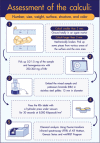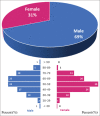The changing composition of urinary calculi in Southern Thailand over the past 14 years
- PMID: 37006209
- PMCID: PMC10062514
- DOI: 10.4103/ua.ua_84_22
The changing composition of urinary calculi in Southern Thailand over the past 14 years
Abstract
Objective: A worldwide increased incidence of urolithiasis has been observed over the past few decades. Insight into the composition of these stones can lead to enhanced medical treatment and outcomes. The objective of this study was to examine the distribution and chemical composition of urinary calculi in Southern Thailand over the past decade.
Materials and methods: An analysis was conducted on 2611 urinary calculi submitted to the Stone Analysis Laboratory, Songklanagarind Hospital, a single stone analysis laboratory in Southern Thailand. The analysis was performed from 2007 to 2020 using Fourier-transform infrared spectroscopy. The demographic results were described using descriptive statistical analyses, and the Chi-square test for trends was performed to identify changes in urinary calculi composition.
Results: The patients' demographic data revealed a male-to-female ratio of 2.2:1; the most common age group of affected men was 50-69 years, whereas the most common age group of affected women was 40-59 years. The most common components found in the calculi were uric acid (30.6%), mixed calcium oxalate with calcium phosphate (29.2%), and calcium oxalate (26.7%). We noted a trend of increasing uric acid calculi for 14 years (P = 0.00493), whereas the trend for the other major components was decreasing.
Conclusion: The most common component of urinary calculi analyzed in Southern Thailand was uric acid, with a significant rising trend in proportion in the past decade; the trend of other major components, such as mixed calcium oxalate-calcium phosphate and calcium oxalate, decreased.
Keywords: Fourier-transform infrared spectroscopy; Southern Thailand; uric acid; urinary calculi; urolithiasis.
Copyright: © 2022 Urology Annals.
Conflict of interest statement
There are no conflicts of interest.
Figures





Similar articles
-
Urinary tract calculi in southern Thailand.J Med Assoc Thai. 2005 Jan;88(1):80-5. J Med Assoc Thai. 2005. PMID: 15960223
-
Spectrum of urinary stone composition in Northwestern Rajasthan using Fourier transform infrared spectroscopy.Indian J Urol. 2018 Apr-Jun;34(2):144-148. doi: 10.4103/iju.IJU_363_16. Indian J Urol. 2018. PMID: 29692509 Free PMC article.
-
Systemic analysis of urinary stones from the Northern, Eastern, Central, Southern and Southwest China by a multi-center study.BMC Urol. 2018 Dec 13;18(1):114. doi: 10.1186/s12894-018-0428-2. BMC Urol. 2018. PMID: 30545321 Free PMC article.
-
Analysis of urinary calculi composition by infrared spectroscopy: a prospective study of 625 patients in eastern China.Urol Res. 2010 Apr;38(2):111-5. doi: 10.1007/s00240-010-0253-x. Epub 2010 Feb 16. Urol Res. 2010. PMID: 20157702
-
Multivariate Analyses of Urinary Calculi Composition: A 13-Year Single-Center Study.J Clin Lab Anal. 2016 Nov;30(6):873-879. doi: 10.1002/jcla.21950. Epub 2016 Apr 13. J Clin Lab Anal. 2016. PMID: 27075109 Free PMC article.
References
-
- Sorokin I, Mamoulakis C, Miyazawa K, Rodgers A, Talati J, Lotan Y. Epidemiology of stone disease across the world. World J Urol. 2017;35:1301–20. - PubMed
-
- Alatab S, Pourmand G, El Howairis Mel F, Buchholz N, Najafi I, Pourmand MR, et al. National profiles of urinary calculi: A comparison between developing and developed worlds. Iran J Kidney Dis. 2016;10:51–61. - PubMed
-
- Tanthanuch M. Urolithiasis in the south. In: Tanthanuch M, Santingamkun A, editors. 30th Anniversary of TUA: Continuing With Pride. Bangkok: Sahamit Pattana Printing Co, Ltd; 2018. pp. 163–8.
LinkOut - more resources
Full Text Sources
Miscellaneous
